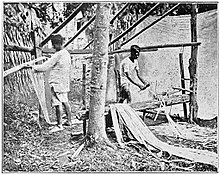This article needs additional citations for verification. (October 2014) |
 Bicolano men preparing hemp by drawing out its fibers, c. 1900 | |
| Total population | |
|---|---|
| 7,079,814 (2020 census)[1] (6.5% of the Philippine population) | |
| Regions with significant populations | |
(Bicol Region, Quezon Province, Northern Samar, Metro Manila, Davao Region, Caraga Region, Soccsksargen, Misamis Oriental) | |
| Languages | |
| Bikol languages, Filipino, English | |
| Religion | |
| Christianity (predominantly Roman Catholicism, with minority Protestantism) Islam, Animism, indigenous folk religion | |
| Related ethnic groups | |
| Tagalogs, Visayans (Masbateños and Warays), other Filipinos |
The Bicolano people (Bikol: Mga Bikolnon) are the fourth-largest Filipino ethnolinguistic group.[2] Their native region is commonly referred to as Bicolandia, which comprises the entirety of the Bicol Peninsula and neighboring minor islands, all in the southeast portion of Luzon. Males from the region are often referred to as Bicolano, while Bicolana may be used to refer to females.
Bicolano people are largely an agricultural and rural people, producing rice, coconuts, hemp, and spices. A great majority of Bicolanos are Roman Catholics, with many towns celebrating festivals in honor of patron saints, and Catholic Mass being celebrated daily in many of the Bicol region's churches. There also exists minority Protestant and Muslim populations among Bicolano people.[3] An undercurrent of animism persists as well; for instance, it is common for Bicolano people to believe that whenever a supernatural entity stalks a house, they will leave centavo coins as compensation.
Bicolano people speak about a dozen closely related dialects of Bikol, largely differentiated according to cities, and closely related to other central Philippines languages, all of which belong to the Austronesian (specifically Malayo-Polynesian) superfamily of languages.[4]
- ^ "Ethnicity in the Philippines (2020 Census of Population and Housing)". Philippine Statistics Authority. Retrieved July 4, 2023.
- ^ "Philippines - the World Factbook". Retrieved January 27, 2014.
- ^ 2015 Census of Population Highlights Demographic Characteristics, 15 August 2015, Philippine Statistics Authority. Accessed 27 December 2021.
- ^ "Bicol - people". Britannica.com. Retrieved 13 August 2018.